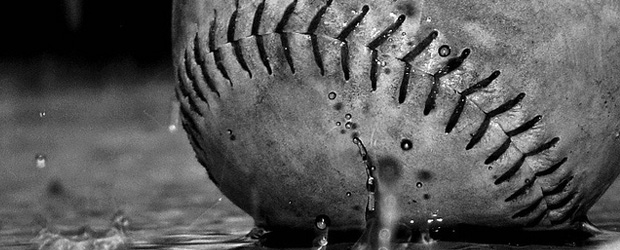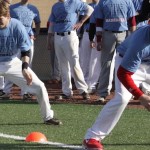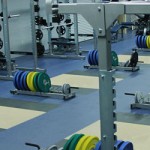The following article is from guest author Alan Jaeger. It was originally published in August 2008 for Performance Conditioning. Alan has given permission for it to be re-published here on The Full Windup. Though it is a few years old, the content and the application are still very relevant to ballplayers today.

Born and raised in sunny, southern California, you might wonder why I feel a need to write an article about a throwing program for inclement weather. Well, the truth be told is that this question has come up a great deal in the past few years. Coaches and players are beginning to realize that being confined to a limited space, indoors, for an extended period of time in the Fall/Winter months (3-5 months in some states) can significantly limit the conditioning and development of the arm. This reality is especially hitting home for those coaches and players who have experienced the tremendous benefits of distance throwing (Long Toss), and are now realizing how disadvantageous it is to suppress the arms needs to stretch out, lengthen and condition properly during this 3-5 month window.
This 3-5 month window, which can start as early as October and can last as late as March, often forces players to train indoors in facilities that may be significantly limited by height and distance constraints (e.g. basketball gym). As you will see throughout this article, this 3-5 month window, when coaches and players often feel that they can’t get the necessary work or conditioning in because they are forced indoors, is one of the most important periods in the calendar year. Quite simply, it represents a huge chunk of time when players can either “build on their base,” or face the real possibility that their arms will either stagnate or regress.
The reality is that while warm weathered parts of the country have the luxury to train outdoors, without throwing limitations, schools that are forced indoors for long periods of time are at a major disadvantage come Spring time if they don’t know how to insure that players get the necessary conditioning indoors (distance throwing/long toss). Going indoors can seem very limiting when it comes to maintaining a good throwing program but with a little creativity players can find ways to get the necessary distances of 200-300 feet even if the length of the indoor facility is no greater than 120 feet.
Considering that the key to any throwing program is to build the base of the arm correctly (September/October), the next most important factor is to ensure that this base is maintained or enhanced through the remainder of the Fall/Winter (and eventually, into the Spring). This period between November and March is a critical time to not only deepen the base that was built in September/October, but to insure that the players make a smooth transition once they get outdoors early in the Spring, without having to “rush” into shape. The arm should be in shape because of how it was properly conditioned throughout the Fall/Winter months, despite the fact that it was confined to indoor throwing.
This article has been written with this in mind.
Two Keys To Conditioning Indoors: Surgical Tubing and Long Toss
For those players or teams that have used the first two months (September/October) to condition their arms well on a Long Toss Throwing Program the last thing you want to have happen is for your players to go from a great conditioning mode to “under conditioning” for 3-5 months because of being “limited” indoors. The arm needs to continue to train in a manner that allows it to fully condition, and that means it needs to find a way to stretch out (Long Toss) to distances that are consistent with the distances that are provided outdoors.
There are two key factors with regard to developing and maintaining the health, strength and endurance of the arm through the Fall/Winter months — number one is distance throwing or long toss, and a close second is surgical tubing exercises. There isn’t anything that’s a close third other than pitchers getting the necessary work off the mound at the appropriate time.
As mentioned in a previous article, building a “base”, progressively and thoroughly, is the most important principle in developing arm health, strength and endurance. And maintaining this base by conditioning properly throughout the Fall/Winter is of extreme importance if you want to use the Fall/Winter to strengthen, rather than deplete this base. “Proper” conditioning starts and ends with Long Toss and Surgical Tubing — these are the only two factors that are not optional.
Once a team is forced to go indoors due to inclement weather these are the two essential ways to maintain your conditioning through the Fall, Winter and into the Spring. If you are fortunate enough to have an indoor facility (field house/football field) that allows you to consistently get out to 250 feet or more, than simply follow your routine as if you are outdoors. But for most of the schools out there, a basketball gym, etc, seems to be more of the norm, and getting distance is a real issue.
Key #1: Surgical Tubing
Though you may be limited by the distance (e.g. 120 feet) and/or the height of your indoor facility you can still effectively supplement the “conditioning” of the arm by adding repetitions to your surgical tubing exercises prior to, and independent of your throwing program.
Fortunately, the net effect of increasing your reps helps the arm “make up” for the lack of throwing each day. This is especially effective by adding reps to the forward throwing motion (literally, the same throwing motion used as if you were “throwing” the surgical tubing like a baseball), which is the last surgical tubing exercise done prior to that days throwing session. This forward motion exercise best “simulates“ the arms throwing motion because, quite simply, the arm is getting the sensation that it is throwing.
There is actually a “Long Toss” effect without even picking up a ball because “throwing” the tubing in a progressive way (start with low resistance and slowly add resistance) allows the arm to “open up” progressively with each passing repetition, in the same manner that you start out by playing light catch, and slowly add more effort to each throw. Because the arm has had a chance to “measure”, for example, the first 25 reps as a stretch, adding reps begins to challenge the arm as if the distance behind the throws is increasing.
Again, this is all done in a safe manner because the arm is progressively being asked to “throw” through more resistance after the arm has already been safely warmed up (the increased resistance is created by slowly moving away from the fence or object that you have clipped the surgical tubing on to).
Over time, a player may actually increase from a distance of 3 feet from the fence and 25 reps, to 4 or 5 feet from the fence and 3 sets of 30 reps. This is ideal for the arm because it is going through basically the same range of motion as if it is throwing, and the resistance (distance) is being increased in a very progressive way. Surgical tubing is not only going to help establish a great base but it’s going to also increase the arm’s endurance in and of itself and best prepare the arm to maximize the effect of the actual throwing program on that given day.
Long Tossing Indoors (into a net if necessary)
Where surgical tubing can help make a significant difference in your ability to both properly warm up and condition the arm without picking up a baseball, getting distance (Long Toss), even in a restricted space, is crucial. Though it may seem very limiting if the length of your facility is no longer than 120 feet the reality is that with a little patience and creativity (and an indoor net), there are ways to get the necessary distance that the arm so desperately needs during this 3-5 month indoor period (as you will see, you can actually throw the ball as far as you want on any given day).
Here’s how it’s done:
Assuming you’ve done a very thorough Arm Care/Surgical Tubing warm up, use the first 5 minutes to have your players play normal catch as if they were outdoors (the first 5 minutes of warm up should come pretty quickly due to the increased work load with the surgical tubing). I would assume that if your players are in good shape they will get out to 120 feet in 6-8 minutes. Once they’ve hit the wall of the indoor facility (ie 120 feet), they can stay there as long as they desire, especially if that’s all the distance they want on that given day (ie they bull-penned the day before). But if it’s a Long Toss day, they should come back in to a net (again, this is assuming you have an indoor batting cage/net) and finish their throwing program the following way: Just as you would expect with regular Long Toss, the more stretched out your arm feels the farther you are going to throw the ball, and the more your going to need to raise your angle. Therefore, as your arm gets looser, keep aiming slightly higher on the net as if you are simulating the same angle as if you were throwing outdoors.
For example, at 60 feet, there is no real angle yet, but as you “move back” in theory every ten feet, your might move your target up one degree or so ( a few inches). That would suggest that after you “moved back” to 100 more feet, your new focal point is raised up to about 10 degrees on the net. Thus, if you were able to throw outdoors as far as 300 feet, your angle up should be approximately 30-35 degrees. Naturally, distance and angle may vary from player to player but the bottom line is that in time, you’ll start to know how high to aim, depending on “how far out you would have gone outdoors”, and how many throws you need to make at each increment. The idea is pretty simple — the more stretched out your arm becomes the more you raise your focal point. As you take your arm through the same motions as if you were long tossing outdoors you will begin to notice that you are getting the same sensation you’re accustomed to feeling at 120 feet, 200 feet, 240 feet and 300 feet. If you are someone who is already intimate with your arm these sensations should come pretty quickly.
Once you get to your desired distance and feel completely stretched out, it is time for the “pull down” or downhill phase of Long Toss (if that is what your workload is that day). This is the time when you would normally come “back in towards” your throwing partner if you were outdoors. So, to simulate this pull down phase into the net imagine that you were coming in toward your partner in 10 foot increments with each passing throw (so it would take you 24 throws, or 240 feet, to go from 300 feet to 60 feet). With each throw, simply lower your focal point on the net by one degree or so, and keep lowering this focal point until you are back to 60 feet. Once back at 60 feet, you may begin to notice that in order to maintain your furthest throw that day (e.g. 250 + feet) you actually have to aim lower than chest height to keep the ball on a line. This is because you are compressing a great deal of distance (250 + feet) into a very short space (60-65 feet). Another way of saying this is to aim 20-30 degrees downhill(your partners waist) and make sure you are maintaining your furthest throw (by not decelerating) and the ball should end up no higher than chest height or so. This lower focal point will teach the body (mind) how to be explosive downhill and how to not decelerate. And if you’re a pitcher, and you want to work on getting even more leverage out in front, simply lower your focal point down to your throwing partners shins or toes and see if you can get it to where the ball is ending up at knee height. Again, it all comes down to lowering your focal point and not decelerating in order to maximize the compression of your furthest throw into your shortest throw; to be in the best position possible to have optimal leverage downhill with explosiveness. If you are a position player you can aim a at your partners belt line (which should equate to the ball ending up at your partners chest if done correctly).
Note: once you come back to approximately 120 feet with your pull downs into the net, it would be ideal to go back out with your throwing partner to the 120 foot range in the gym and finish your pull down phase back in to 60 feet with your partner. Naturally, throwing the ball to someone rather than into the net will give you more realistic feedback.
By the end of your pull downs, you will have taken your arm through the same Long Toss throwing routine as if you were outdoors, without any height or distance restrictions. In essence, what the arm needs is full range of motion uphill and downhill just as if it had been throwing outdoors without any restrictions. This ability to “stretch” the arm out thoroughly, and “pull down” aggressively through a well prepared arm is what allows the arm to best condition — it’s what allows the arm to evolve, rather than regress indoors.
A Smoother Transition into the Spring
What you do during the time you are forced indoors is not only crucial to the development and maintenance of a players arm, but also, to allowing pitchers/players to make a smooth transition into the Spring when they do go outdoors. Remember, when players get outdoors after being indoors for months they are often excited and in a “hurry” to get going. If their base was not maintained and strengthened well indoors you may have a lot of players vulnerable to breaking down simply because they have gone from 1st gear to 5th gear in a couple of days. When a pitcher/player rushes into shape the first thing that tends to suffer is recovery period, which is also a sign of poor conditioning (poor recovery period is a sign that the arm is heading into a precarious position). In either case, players who didn’t do the proper work to condition and maintain the health, strength and endurance of their arm indoors are very vulnerable to not only losing arm strength, but to breaking down.
In Summary
Conditioning the arm indoors through the Fall/Winter months is imperative. Emphasizing Surgical Tubing/Arm Care exercises is Step 1.…Step 2 is Long Toss. Though it may seem difficult to throw 300 feet into a 120 foot space it can be done. Put rather bluntly, there is no substitution for distance throwing (Long Toss) — it, along with Surgical Tubing exercises, is the most important factor in the development and maintenance of a players arm throughout the Fall/Winter months, and to best ensure a safe transition period into the Spring. Again, it’s all about making the time and being creative. Now that you are aware that there is a way to condition and develop your players’ arms thoroughly, despite the “limits“ of being forced indoors for a rather significant period of time, you can do something about it.






One response to “Off-Season Throwing Program For Inclement Weather (Fall/Winter)”
[…] you live in a warm weather state, chances are you can get out to a field almost anytime of year. For those times when the weather doesn’t cooperate, you need to have a secondary facility that you know you can use to get your […]